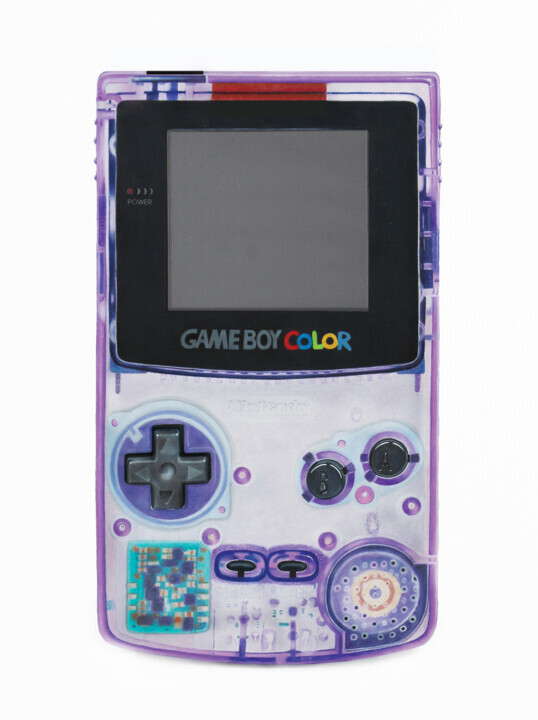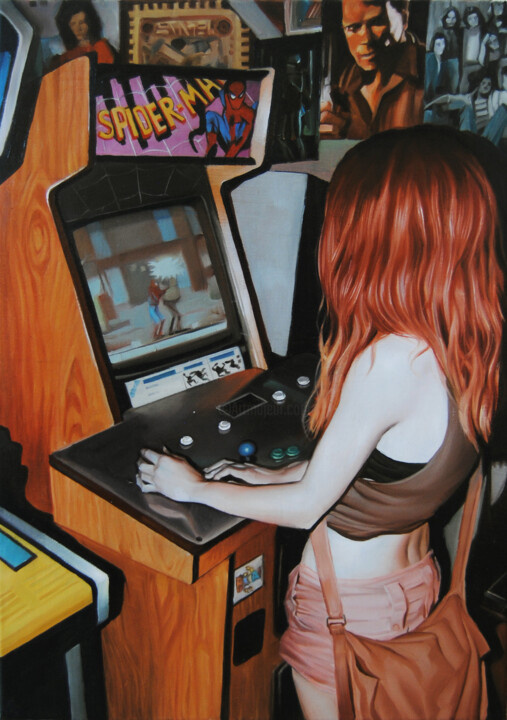 Daniel García, Happy 80's, 2022. Oil on canvas, 55 x 38 cm.
Daniel García, Happy 80's, 2022. Oil on canvas, 55 x 38 cm.
Are video games art?
"Art is a diverse range of human activities, and resulting products, involving creative or imaginative talent expressive of technical skill, beauty, emotional power, or conceptual ideas."
Referring to the simplest and most accessible definition of art, found on Wikipedia, widely circulated democratic online encyclopedia, video game could indeed be associated with the more traditional forms of creativity, as a technological medium in which the avant-garde of science dialogues with more customary forms of artistic expression, such as sculpture, illustration, storytelling, and music, which combine to create a new, completely autonomous genre. In addition, referring to the thought reported in DailyGamer, art also represents a true means of indirect communication, aimed at materializing through three components, which relate to each other: the messenger (the artist), the message (the artwork) and the receiver (the audience)[1]. Similarly, in the world of video games we find the artist (creator-designer), who, through his work (video game), marked by a peculiar mode of transmission of emotions, wants to send his personal message to the user, who has the task of "living" and interpreting it in his own way. Precisely from the verb "live" emerges a further peculiarity related exclusively to the world of video games, namely their interactive aspect, capable of involving the audience in the most complete personalization of its experience . However, to date, the recognition of video games as a true post-modern art form is not yet official, first, because at the moment there is no game that can be considered definitely such and, second, because a part of the population is not yet ready to take this step, just as the famous film critic Roger Ebert, who, until the date of his death in 2013, openly stated: "Video games can never be art" and "No one inside or outside the field has ever been able to quote a game worthy of comparison with the great poets, filmmakers, novelists and poets. "
 Frédéric Durieu & Nathalie Erin, Mister moustache, 2018. 2D digital work on aluminum, 80 x 60 cm.
Frédéric Durieu & Nathalie Erin, Mister moustache, 2018. 2D digital work on aluminum, 80 x 60 cm.
 Laurent Gros, Inky, 2021. Plastic sculpture, 70 x 70 x 2 cm.
Laurent Gros, Inky, 2021. Plastic sculpture, 70 x 70 x 2 cm.
"Gamification": video games enter museums
Leaving aside the aforementioned debate, it is now evident how video games are beginning to impose themselves within the containers of works of art par excellence, that is, museums, where they present themselves as interactive tools for the dissemination of knowledge regarding the collections, capable of involving the viewer in a playful and active way in the museum narrative, generating a particular, unique, unrepeatable and experimental experience of visiting and learning. In this context, the possibilities for the use of video game technology turn out to be limitless, to say the least, as an archaeological institution can use an application to show how the housed artifacts looked like in the past, while a museum that mainly collects paintings could propose the use of virtual reality in order to explore how certain masterpieces were made, and much more... This new mode of museum enjoyment, aimed at involving playful tools, falls under the definition of "gamification," a term for the use of elements borrowed from games and game design techniques in initially not-so-light contexts. Finally, regarding the impact found by this latest trend on learning, it is worth highlighting how gaming, employed within cultural institutions, succeeds in fostering the development of greater autonomy and independence of visitors, who, opposed to the more classic, judgmental and passive frontal view of artifacts, turn out to be more natural, light and involved, appear to be more open and motivated toward study.
 Olga Guseva, Clinking coins n. 1, 2021. 2D digital work / digital painting on canvas, 100 x 100 cm.
Olga Guseva, Clinking coins n. 1, 2021. 2D digital work / digital painting on canvas, 100 x 100 cm.
 Doat, Collection "Chanel Autrement"/Tetris, 2020. Film photograph on paper, 30 x 25 cm.
Doat, Collection "Chanel Autrement"/Tetris, 2020. Film photograph on paper, 30 x 25 cm.
Video games in the artworks of Artmajeur artists
Referring to the above, it is evident how the presence of video games in the artistic field can be found, both in the sphere of graphic experimentation, although little recognized and valued, and in the museum context. In addition to these two realities, which are also to be actively experienced, the aforementioned devices present a third link to the creative universe, which, though more passive, contemplative and frontal, is realized in contemporary works, which immortalize the world of video games, just as the work of Artmajeur artists demonstrates, particularly that of Vincent Sabatier (VerSus), Jordanna Ber, and Emmanuel Passeleu.
 Vincent Sabatier (VerSus), Roboclusion SuperMario screen printing, 2020. Serigraph on paper, 70 x 50 cm.
Vincent Sabatier (VerSus), Roboclusion SuperMario screen printing, 2020. Serigraph on paper, 70 x 50 cm.
Vincent Sabatier (VerSus): Roboclusion SuperMario screen printing
VerSus's silkscreen print immortalizes subjects that are highly representative of the Neo-pop trend, an artistic current, which, developed since the 1990s, has pursued the intention of carrying forward, and make current, the "research" on mass consumer society initiated by Pop art in the late 1950s and early 1960s. In fact, the French artist's work brings together some of the most famous characters from the toy and video game industry of the 20th century, such as the best-known protagonists of Super Mario Bros, who are contained within a giant, transparent LEGO little man. As a result, the screen printing constitutes a real narrative plot, probably aimed at celebrating, in one context, the different protagonists of our childhood, but also of adult life, as evidenced by the die-hard collectors of themed gadgets. About VerSus's artistic investigation, on the other hand, it is good to highlight how his production of sculptures and serigraphs, is largely focused on the aforementioned reproduction of the features of the most classic and simple "minifig" (Lego character), which, as a kind of ideal "chest" of memories, lends itselves to accommodate within it the most varied symbols of contemporary pop culture.
 Jordanna Ber, Gameboy color, 2021. Drawing, pencil on paper, 70 x 50 cm.
Jordanna Ber, Gameboy color, 2021. Drawing, pencil on paper, 70 x 50 cm.
Jordanna Ber: Gameboy color
Another Pop work, perfect for celebrating the icons of the 20th century gaming universe, is Jordanna Ber's drawing, which, by simply immortalizing an intense close-up of a Game boy color, treats the electronic object almost as a demigod to be worshipped. Such a "blasphemous" approach is probably due to the fact, that, this 1998 device, along with the first black-and-white Game boy from 1989, represented one of the best-selling portable game consoles in Nintendo's history, becoming a true legend in the video game market. Going into the details of the matter, the Game Boy color, together with its predecessor, sold some 118 million units across the globe, turning into the most recognizable devices of the 1980s and 1990s, as well as cultural and social icons still well present in the collective imagination. Speaking instead of the link between the aforementioned console and the creative world, it is interesting the project carried out by Grid Studio, aimed at restoring, disassembling and framing Game boys, in order to present them, in all their components, inside display cases, probably pursuing the goal of transforming the electronic object into a nostalgic generational narrative.
 Emmanuel Passeleu, Tetris I, 2021. Digital photograph / manipulated photograph on paper, 60 x 60 cm.
Emmanuel Passeleu, Tetris I, 2021. Digital photograph / manipulated photograph on paper, 60 x 60 cm.
Emmanuel Passeleu: Tetris I
In Emmanuel Passeleu's photography, once again, art meets and narrates the most famous video games of the 20th century, through a particular, eccentric and highly innovative point of view on the reality around us. In fact, the Artmajeur artist's architectural shot has been cleverly manipulated in order to pay homage, in a rather ironic and surreal way, to the typical interlocking constructions of the best-selling game in history: Tetris. In any case, however, as stated by the photographer himself, the artist's message turns out to be even more complex and profound than a simple reference, since Tetris I pursues the intent to strongly denounce the modern custom of making buildings too quickly, that is, without even having time to consider the resulting transformations of the landscape. Returning to the video game, Tetris, invented on June 6, 1984 by the young programmer of the Academy of Sciences of the Soviet Union Aleksej Pažitnov, is characterized by a rather paradoxical architectural "mission," in that, generally, one does not build in order to destroy immediately afterwards. Consequently, in this context of "extravagance" well fits the whimsy of Emmanuel Passeleu, who, by immortalizing buildings in the style of the iconic video game with his shot, destined them never to be torn down.
Ressources:
- Note [1] : Filippo Giacometti "I videogiochi sono una forma d'arte?" published in 2018 in DAILYGAMER.IT https://www.dailygamer.it/i-videogiochi-sono-arte/


 Olimpia Gaia Martinelli
Olimpia Gaia Martinelli